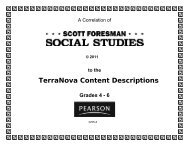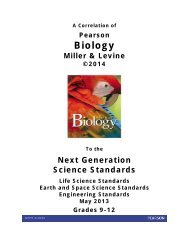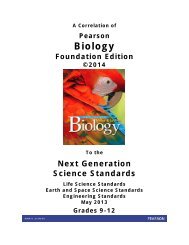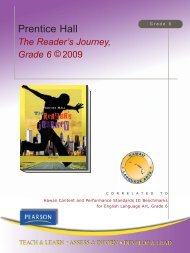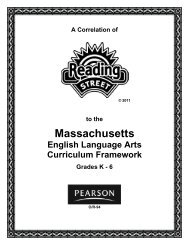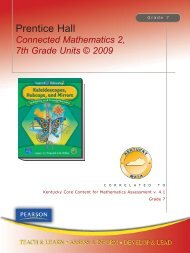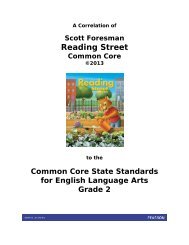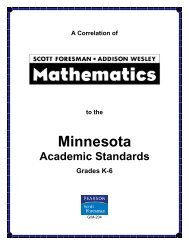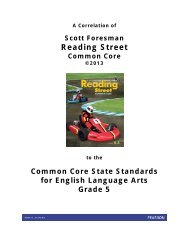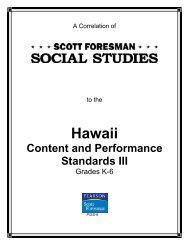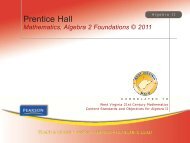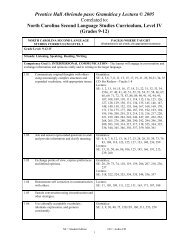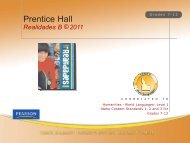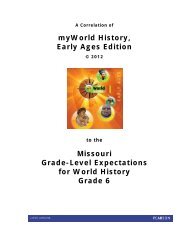Prentice Hall Science Explorer â 16 Book Series © 2009 ... - Pearson
Prentice Hall Science Explorer â 16 Book Series © 2009 ... - Pearson
Prentice Hall Science Explorer â 16 Book Series © 2009 ... - Pearson
You also want an ePaper? Increase the reach of your titles
YUMPU automatically turns print PDFs into web optimized ePapers that Google loves.
<strong>Prentice</strong> <strong>Hall</strong> <strong>Science</strong> <strong>Explorer</strong> – <strong>16</strong> <strong>Book</strong> <strong>Series</strong> © <strong>2009</strong><br />
Correlated to:<br />
Connecticut Core <strong>Science</strong> - Content Standards and Expected Performances<br />
(Grades 6-8)<br />
CONNECTICUT CORE SCIENCE - CONTENT<br />
STANDARDS AND EXPECTED<br />
PERFORMANCES<br />
Expected Performances<br />
C15. Describe the basic structures of an<br />
animal cell, including nucleus, cytoplasm,<br />
mitochondria and cell membrane, and how<br />
they function to support life.<br />
PAGE(S) WHERE TAUGHT<br />
(If submission is not a text, cite<br />
appropriate resource(s))<br />
From Bacteria to Plants<br />
SE/TE: <strong>16</strong>-24; Active Art: cep-3012; Discover<br />
Activity: <strong>16</strong>; Discovery Channel School Video<br />
Field Trip: 23; Figure: 20-21; Key Terms: <strong>16</strong>;<br />
Target Reading Skills: <strong>16</strong>; Try This Activity:<br />
18, 22; Writing in <strong>Science</strong>: 24<br />
C<strong>16</strong>. Describe the structures of the human<br />
digestive, respiratory and circulatory<br />
systems, and explain how they function to<br />
bring oxygen and nutrients to the cells and<br />
expel waste materials.<br />
C17. Explain how the human musculoskeletal<br />
system supports the body and allows<br />
movement.<br />
TE: Address Misconceptions: 4G, 18;<br />
Differentiated Instruction: 17, 19, 21, 23;<br />
Monitor Progress: 17, 19, 21, 23;<br />
Performance Assessment: 24; Teacher Demo:<br />
19, 21; Teach Key Concepts: 17, 18, 19, 22,<br />
23; Use Visuals: 20, 22<br />
Human Biology and Health<br />
SE/TE: 60-67, 78-84, 112-121; At Home<br />
Activity: 65; Discover Activity: 60, 78, 85,<br />
112; Key Terms: 60, 78, 85, 112; Math<br />
Analyzing Data: 64; Skill Activity: 82; Skill<br />
Lab: 66-67, 21; Target Reading Skills: 60,<br />
78, 85, 112; Try This Activity: 63 Writing in<br />
<strong>Science</strong>: 84<br />
TE: Build Inquiry: 81, 82, 115, 1<strong>16</strong>, 119;<br />
Differentiated Instruction: 61, 64, 80, 81, 83,<br />
113, 115, 117; Monitor Progress: 79, 81, 83,<br />
84, 113, 115, 117, 119, 120; Performance<br />
Assessment: 19, 28, 35, 65, 84, 89, 97, 120,<br />
180, 221, 231; Teacher Demo: 62; Teach Key<br />
Concept: 61, 62, 63, 64, 79, 82, 113, 114,<br />
118<br />
Human Biology and Health<br />
SE/TE: 12-19, 24-29; At Home Activity: 19;<br />
Discover Activity: 12, 24; Key Terms: 12, 24;<br />
Skill Activity: 15; Skill Lab: 29; Target<br />
Reading Skills: 12, 24; Try This Activity: <strong>16</strong>,<br />
26; Writing in <strong>Science</strong>: 28<br />
TE: Build Inquiry: 15, 17, 27; Differentiated<br />
Instruction: 13, 17, 25, 27; Monitor Progress:<br />
13, 15, 17, 19, 25, 27, 28; Performance<br />
Assessment: 19, 28; Teach Key Concept: 13,<br />
14, <strong>16</strong>, 18, 25, 27<br />
40<br />
SE = Student Edition - TE = Teacher Edition



